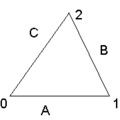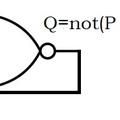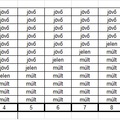- Van-e tapasztalati bizonyíték arra, hogy a nyílnak minden egyes időpillanatban van sebessége? Igen van. Helyezzünk apró mágnest a nyílvesszőre, majd lőjük át egy kellően nagy átmérőjű indukciós tekercsen (solenoid), és oszcilloszkópon figyeljük meg az indukált feszültség jelleggörbéjét. Látni fogjuk, hogy miközben a nyílvessző mozog a solenoid belsejében, folyamatosan feszültséget mérünk, aminek az oka, a nyíllal együtt mozgó mágnes. Ezzel igazoltuk, hogy a mozgó nyílnak folyamatosan (minden időpillanatban) van sebessége.
- Milyen következményei lennének az idő és tér atomos szerkezetű feltételezésének? A távolság fogalmát nem tudnánk a szokásos módon, egyértelműen meghatározni; a sebesség változása esetén pedig diszkrét időben más sebesség adódna az előző, és más a következő idő atom figyelembe vételével, azaz a sebesség a test pillanatnyi helyzetére vonatkoztatva nem lenne egyértelmű. Talán mindkét probléma orvosolható valamilyen módon, de a probléma jelentkezése világosan mutatja, hogy a klasszikus szemlélet mennyire indokolt és jól megalapozott.
Kiegészítés angolul tudóknak. Az alábbiak különféle álláspontokat reprezentálnak, van, amivel egyetértek, van, amivel nem, de az utóbbiak is érdekesek és tanulságosak:
https://faculty.washington.edu/smcohen/320/ZenoArrow.html
Zeno’s Paradox of the Arrow (S. Marc Cohen)
A reconstruction of the argument (following 9=A27, Aristotle Physics 239b5-7:
- When the arrow is in a place just its own size, it’s at rest.
- At every moment of its flight, the arrow is in a place just its own size.
- Therefore, at every moment of its flight, the arrow is at rest.
Aristotle’s solution:
The argument falsely assumes that time is composed of “nows” (i.e., indivisible instants).
There is no such thing as motion (or rest) “in the now” (i.e., at an instant).
Weakness in Aristotle’s solution: it seems to deny the possibility of motion or rest “at an instant.” But instantaneous velocity is a useful and important concept in physics:
The velocity of x at instant t can be defined as the limit of the sequence of x’s average velocities for increasingly small intervals of time containing t.
In this case, we can reply that if Zeno’s argument exclusively concerns (durationless) instants of time, the first premise is false: “x is in a place just the size of x at instant i” entails neither that x is resting at i nor that x is moving at i.
Perhaps instants and intervals are being confused
“When?” can mean either “at what instant?” (as in “When did the concert begin?”) or “during what interval?” (as in “When did you read War and Peace?”).
1a. At every instant at which the arrow is in a place just its own size, it’s at rest. (false)
2a. At every instant during its flight, the arrow is in a place just its own size. (true)
1b. During every interval throughout which the arrow stays in a place just its own size, it’s at rest. (true)
2b. During every interval of time within its flight, the arrow occupies a place just its own size. (false)
Both versions of Zeno’s premises above yield an unsound argument: in each there is a false premise: the first premise is false in the “instant” version (1a); the second is false in the “interval” version (2b). And the two true premises, (1b) and (2a), yield no conclusion.
A final reconstruction
In this version there is no confusion between instants and intervals. Rather, there is a fallacy that logic students will recognize as the “quantifier switch” fallacy. The universal quantifier, “at every instant,” ranges over instants of time; the existential quantifier, “there is a place,” ranges over locations at which the arrow might be found. The order in which these quantifiers occur makes a difference! (To find out more about the order of quantifiers, click here.) Observe what happens when their order gets illegitimately switched:
(1c) If there is a place just the size of the arrow at which it is located at every instant between t0 and t1, the arrow is at rest throughout the interval between t0 and t1.
(2c) At every instant between t0 and t1, there is a place just the size of the arrow at which it is located.
We will use the following abbreviations:
L(p, i):=The arrow is located at place p at instant i
R:=The arrow is at rest throughout the interval between t0 and t1
The argument then looks like this:
(1c) If there is a p such that for every i, L(p, i), then R.
∃p ∀i L(p, i) → R
(2c) For every i, there is a p such that: L(p, i).
∀i ∃p L(p, i)
But (2c) is not equivalent to, and does not entail, the antecedent of (1c):
There is a p such that for every i, L(p, i)
∃p ∀i L(p, i)
The reason they are not equivalent is that the order of the quantifiers is different. (2c) says that the arrow always has some location or other (“at every instant i it is located at some place p”) - and that is trivially true as long as the arrow exists! But the antecedent of (1c) says there is some location such that the arrow is always located there (“there is some place p such that the arrow is located at p at every instant i”) - and that will only be true provided the arrow does not move!
So one cannot infer from (1c) and (2c) that the arrow is at rest.
The Arrow and Atomism
Although the argument does not succeed in showing that motion is impossible, it does raise a special difficulty for proponents of an atomic conception of space. For an application of the Arrow Paradox to atomism, click here.
--------------------------------------
Mortensen, Chris, "Change and Inconsistency", The Stanford Encyclopedia of Philosophy (Winter 2016 Edition), Edward N. Zalta (ed.), URL = <https://plato.stanford.edu/archives/win2016/entries/change/>.
Kiemelek az érdekes tanulmányból két erősen vitatható pontot:
7p. If the cars’s position function f is given by, say, f(t) = t2, then its speed is 2t. If motion is defined as having non-zero speed, then the car is motionless at t=0. On the other hand, at all it is in motion, so there is surely no puzzle about when it could ever begin: there is no first instant of motion. Az egyenletek a dimenziók figyelembe vételével hibásak: az idő négyzete nem távolság, az idő konstanssal szorozva nem sebesség. Helyesen: f(t) =1/2 * a * t2(’a’ a gyorsulás mértéke), a sebesség (v) pedig v=a * t.
8p. However, there are more troublesome special cases. Suppose that the car’s position function is given by: f(t) = for all 0<t, else f(t)= t. Then speed is zero for all t<0, and speed is 1 for all t>0. But what of ? Helyesen f(t)= v * t, és v=1 m/sec A válasz: 1, mivel a függvény értelmezett a 0 helyen, tehát ott derivált értéke is van.
------------------------------------------------
C.D.McCoy: On Classical Motion (2018) Philosophers’ Imprint (forthcoming)
Abstract: The impetus theory of motion states that to be in motion is to have a non-zero velocity. The at-at theory of motion states that to be in motion is to be at different places at different times, which in classical physics is naturally understood as the reduction of velocities to position developments. I first defend the at-at theory against the criticism raised by Arntzenius that it renders determinism impossible. I then develop a novel impetus theory of motion that reduces positions to velocity developments. As this impetus theory of motion is by construction a mirror image of the at-at theory of motion, I claim that the two theories of motion are in fact epistemically on par—despite the unfamiliar metaphysical picture of the world furnished by the impetus version.
----------------------------------------------
Professor Angie Hobbs moves on to describe The Arrow paradox, which is perhaps the most challenging of all Zeno's paradoxes.
So, onto the arrow Aristotle says that all the Zeno's paradoxes denying the possibility of motion present problems to those, who try to solve them and I think, we're going to find this is particularly true about the arrow. So, according to Aristotle, Zeno claims that the flying arrow is at rest. Notice just how paradoxical this is. The air has already got to be in motion. It's got to be flying for the paradox to work. If you said the motionless arrow is motionless, that's not a paradox. It's the fact, it's the flying arrow is at rest that's, what makes this so particularly tricky. Now Aristotle says that this only works paradox, only works, he claims, if you regard time as composed of 'nows'. In the Greek ‘ecto nuna nuna’ being the word for ‘now’, and that, if you don't regard time like this, the paradox doesn't follow. So we're going to first of all construct a paradox, but then, we're going to have to ask do we have to regard time as composed of ‘now’, what does ‘now noon’ mean, and the Greek, anyway but first let's see how we know constructed this arrow paradox, at least as according to Aristotle. And don't forget we don't have Xena's book of 40 paradoxes, we just have a few of them paraphrased, interpreted outlined, we don't quite know what in later writers, such as Aristotle.
So first of all premise 1:
*(1) Anything occupying a place just its own size is at rest.
**(2) In the present, in the now the noon, what is moving occupies a place just its own size.
(3) In the present what is moving is at rest. (1)(2)
***(4) For what is moving always moves in the present.
conclusion:
***(5) What is moving is always throughout its movement at rest. (3)(4)
Okay, so the claim is that, everything is at rest for any temporal interval, during which it occupies a place equal to itself. But one might counter, this is only true, if the thing in question, say the arrow, occupies the same place for that stretch of time. The moving arrow clearly doesn't do this, it does not occupy the same place for that stretch of time. But what if time were not infinitely divisible, as in the dichotomy and Achilles and the tortoise. But finitely divisible into indivisible minimal indivisible chunks, wouldn't the arrow then be trapped in one indivisible chunk of time, and therefore in the same place for this indivisible chunk, and therefore motionless. And if you're meant to regard the entire flight of the arrow is composed of these indivisible chunks, then the arrow would be motionless throughout its flight, just as we know claims. So problems arise, if we think of time as composed of mouths of periods with a dimension as tiny indivisible chunks of time. So let's suppose that time is after all infinitely divisible, and that now refers to a moment a dimensionless instant now. At first glance this would seem to give us a way out, as we can say okay, admittedly you can't tell whether the arrow is moving or not moving at any one dimensionless moment, because you would need reference to at least two dimensionless moments to work out whether the arrow has proved, but this does not mean that, you can say that the arrow is not moving throughout its flight, because the flight is not a composed of a series of dimensionless moments. No stretch of time is composed of a series of moments any more, than a line in space is composed of it's dimensionless points. This looks more promising. We've got the moving arrow moving again, but we still have a huge problem on our hands, and it concerns the nature of time, because: when exactly does the moving arrow move, if the present then now is simply a dimensionless moment. What is the present, if it's simply a dimensionless dividing line between past and future? When does the arrow possibly move, maybe we can only ever say that the arrow has moved and not that it is moving now. So problems arise with the arrow paradox whether we think of time as finitely or infinitely divisible, and if time exists, it must be one or the other. So maybe time doesn't exist just the xenos master Parmenides had originally claimed.






